Articles and photo stories on this page were featured on our Home page. They remain relevant and have been moved here to provide those interested with a Reference Library of past articles, while freeing up space on the Main page for newer material.
The research articles as well as the photo stories have been arranged by date from most recent to oldest.
Past Research Articles and Photo Stories

(Matt Webb and Bob Mulvihill)
Research Articles
THE FIRST BALD EAGLE FOUND IN JAPAN
(January 30, 2020)

A Japanese friend of 3RBC member Trini Regaspi sent her an article on a Bald Eagle appearing in Hokkaido, Japan's northernmost main island, on January 27, 2020, the FIRST reported Bald Eagle in Japan! Hokkaido has a large population of Steller's Sea Eagles, but now there is a new species there. We westerners yearn to see Asian birds that may fly east to Alaska or the West Coast and record them as ABA sightings, but this is a North American bird that flew west to Japan, giving Japanese birders a treat.
Close viewing of the photo from Japan shows a near full adult eagle, purportedly a female, with dark feathers on its head and small black tips on its tail. This advanced stage of molt would put the bird's age as a late four-year or early five-year eagle.
The story is reported in Japanese by The Hokkaido Shimbun Press
KIRTLAND'S WARBLER SUCCESS STORY: IT'S NO LONGER LISTED AS ENDANGERED
(October 11, 2019)
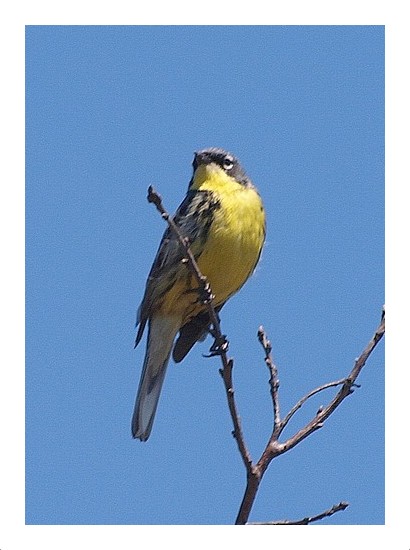
Thanks to extensive recovery efforts, Kirtland's Warbler populations have surged over the last 40 years, leading to the species' removal from the U.S. endangered species list.
The U.S. Fish and Wildlife Service (USFWS) announced the official delisting rule on October 8 at a ceremony on the campus of Michigan State University in East Lansing.
"The delisting of the Kirtland's Warbler is cause for celebration and proof that the Endangered Species Act works, " said Shawn Graff, Vice President of American Bird Conservancy's Great Lakes program. "But this warbler is still among the rarest, most range-restricted migratory songbirds in North America. It is conservation-reliant, meaning that continued management efforts are imperative for the population to hold its ground and continue to expand. "
The Kirtland's Warbler was among the first species listed when the Endangered Species Act was enacted in 1967. At that time, the warbler was found only in a few isolated areas of Michigan's Lower Peninsula during the breeding season. During parts of the 1970s and 1980s, the Kirtland's Warbler population totaled fewer than 200 singing males before beginning its recovery.
The Kirtland's Warbler continues to do well in its historic stronghold while expanding its breeding range into areas of Michigan's Upper Peninsula, Wisconsin, and Canada. The species rebounded to include more than 2,300 breeding pairs by 2015. This progress doubled the original recovery goal set by USFWS.
American Bird Conservancy is playing a lead role to ensure needed conservation efforts for the Kirtland's Warbler continue after delisting. ABC has worked closely with a wide range of partners through the Kirtland's Warbler Conservation Team to develop a comprehensive business plan that addresses the warbler's needs across its life cycle, setting a course for post-ESA success.
ABC also has launched a long-term fund, raising private resources to maintain conservation support and meet emerging needs for the species in the future. The fund is being managed to generate sustainable revenue for important research, habitat development, and community outreach efforts throughout the species' range.
This revenue will complement continuing efforts of state and federal agencies to maintain the highly specific habitat the Kirtland's Warbler needs for breeding, and to limit impacts from Brown-headed Cowbirds, which contributed to its decline through brood parasitism. This private-public partnership represents a new model for addressing the ongoing needs of a delisted, conservation-reliant bird species.
These efforts were made possible thanks to major philanthropic support from the Harry A. and Margaret D. Towsley Foundation of Midland, Michigan.
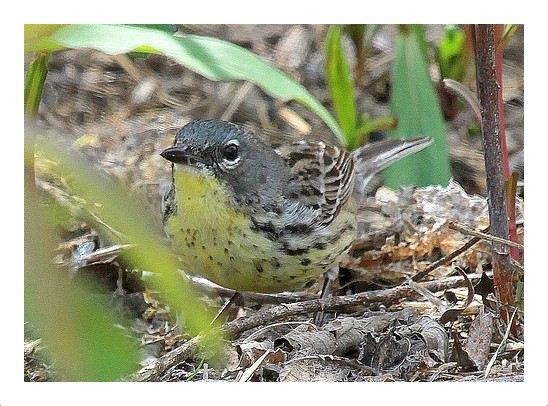
Another asset to ongoing Kirtland's Warbler conservation is Dr. David Ewert, ABC's Kirtland's Warbler Program Director, who is one of the leading researchers and conservationists focused on the species' recovery. Ewert has studied the species for nearly 20 years and currently leads ABC's efforts to support the Kirtland's Warbler on its non-breeding range in The Bahamas. He serves on the board of the Kirtland's Warbler Alliance and leads the Kirtland's Warbler Conservation Team's Non-breeding Range Subcommittee.
In 2018, ABC helped establish a full-time Avian Science Officer position in The Bahamas with a heavy focus on conserving Kirtland's Warblers during the non-breeding season. Working through the Bahamas National Trust, with funding provided via ABC by a private donor in Michigan, Bradley Watson has been pursuing specific priorities identified in the conservation management plans for the species' winter range. Watson's work includes population monitoring, habitat enhancements, and community engagement to support conservation. He also supports efforts to protect the Bahama Oriole, Bahama Nuthatch, and other rare, declining, and endemic bird species found in The Bahamas.
In addition to the Towsley Foundation's support, the Michigan Department of Natural Resources and the U.S. Forest Service are also pledging their commitment to continue habitat management and engage in partnerships that support the Kirtland's Warbler's population growth.
Concerned citizens and organizations can invest in the Kirtland's Warbler's ongoing recovery with a contribution to ABC's long-term fund by visiting Kirtland's Warbler Donation.
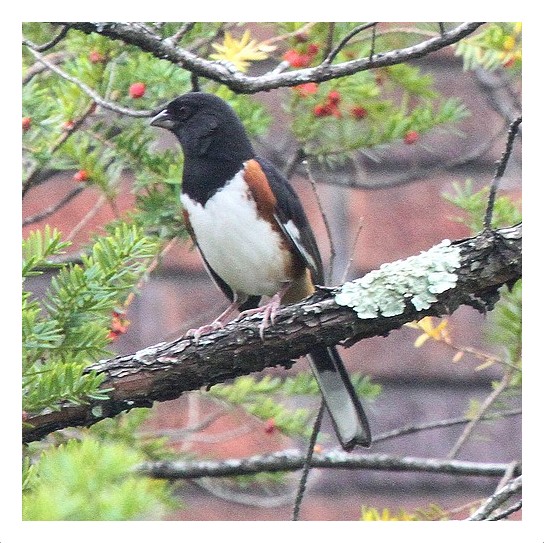
3RBC MEMBER IS LISTENING TO THE BIRDS
(February 26, 2019)
Tessa Rhinehart, a research programmer at Pitt, is part of a group working on a project to
-
a) record bird calls, chips, and songs,
b) turn those sounds into spectrograms so a computer can 'learn' them, and
c) create a device to identify birds by 'hearing' their calls.
Read about this program through this link: Pitt Researchers Are Eavesdropping On Birds In The Name Of Science.
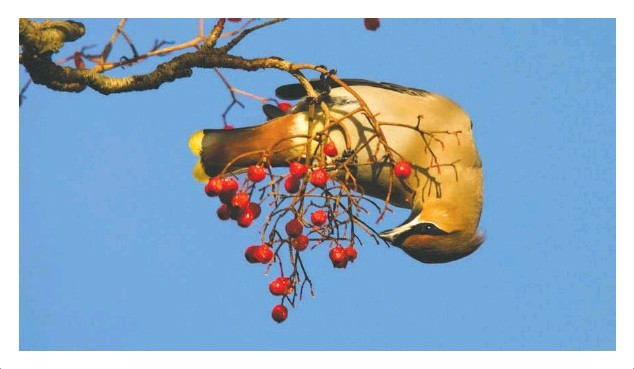
MINNESOTA TOWN HAS INTOXICATED BIRDS!
(October 4, 2018)
An article in The Smithsonian Magazine described the antics Bohemian Waxwings got into after they ate berries with fermented juices leaving the birds 'drunk and disorderly!'
Read it here: "Birds Are Acting Erratically in Minnesota. Blame It on the Alcohol."
CAN SEA DUCKS HEAR UNDERWATER?
(August 28, 2018)
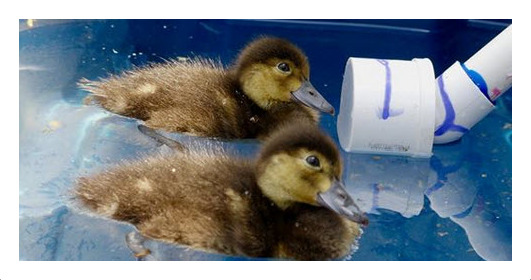
Diving sea ducks are often caught in fishing nets and killed. One researcher is trying to prevent this tragedy by learning how ducks hear underwater in order to create warning systems from fishing vessels similar to those used to warn off marine mammals.
See details of this study in this New York Times article with video: What Do Ducks Hear? And Why Do We Care?.
Thanks to Michelle Kienholz for bringing our attention to this article.
PURPLE MARTIN ROOST IN ALLEGHENY COUNTY
by Paul Hess (August 2018)
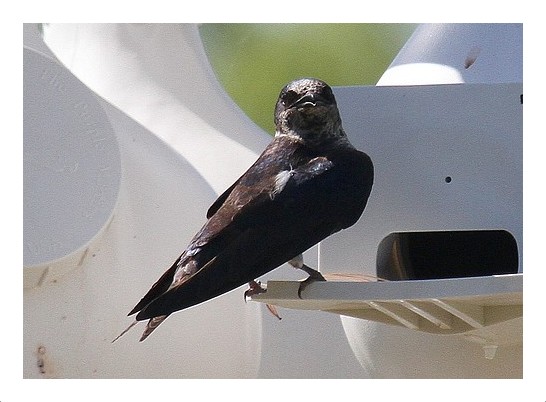 Large numbers of Purple Martins from breeding colonies in our region gather annually in August at a spectacular roost site in northeastern Allegheny County. The birds rest before setting out on an epic migration to spend the winter in Brazil.
Large numbers of Purple Martins from breeding colonies in our region gather annually in August at a spectacular roost site in northeastern Allegheny County. The birds rest before setting out on an epic migration to spend the winter in Brazil.
The location is along the Allegheny River at Natrona Lock and Dam No. 4. Ken Kostka of Natrona Heights, an expert in Purple Martin biology and founder of the Purple Martin Preservation Alliance, established a breeding colony there in 2005.
Now the site has been attracting a large flock of annual fall migrants. See Ken's YouTube video of the flock swirling over the river at dusk before roosting in trees for the night on August 30, 2018, on our Videos page.
An ornithologist trained in estimating flock sizes estimated this year's roosting group at a maximum of approximately 2,500 birds, compared to approximately 1,000 Ken estimated in August 2017. The site is evidently becoming more popular.
Ken offers some background: "As far as I know, the roost has only been active for the past two years. It formed around the active 20-pair colony on site. The birds arrive shortly before dark, fly around at an altitude of 100 to 300 feet like a big school of fish, and then land in several trees to sleep for the night, departing in the pre-dawn hours.
"We think it is safe to say that martins breeding at and fledged from colonies at least 50 miles in all directions (and probably more) come together to join/form this roost. It is also possible that martins from further north use it as a stop-over point while migrating. We just aren't sure! There's a lot we don't know."
The roost itself is not open to public viewing because it is on restricted U.S. Army Corps of Engineers property, although it could be viewed from a boat. However, the swirling flocks can be watched from the corner of River Road and Federal Street along the river's edge at Natrona.
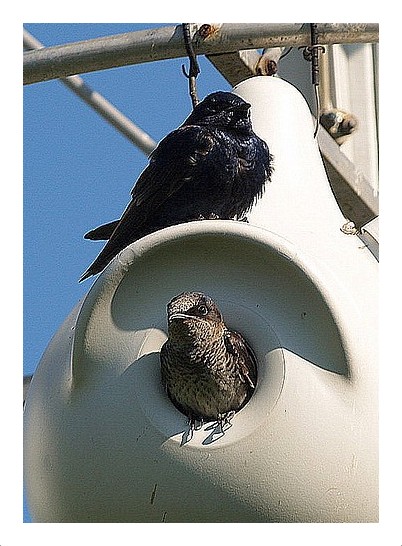 The birds typically begin to form the roost in early August, and the gathering ends with their departure southward in late August or early September. Mark your calendar to see the swarm next August.
The birds typically begin to form the roost in early August, and the gathering ends with their departure southward in late August or early September. Mark your calendar to see the swarm next August.
For an extensive history of this and other Purple Martin nesting colonies in southwestern Pennsylvania, see Ken's Purple Martin Preservation Alliance website at Purple Martin.
Another martin note: Northwestern Pennsylvania is known internationally for a pioneering study in 2007 and 2008, which was conducted in a breeding colony at Edinboro Lake in Erie County. Researchers used tiny devices called light-level geolocators to track the timing and direction of martins' fall migration south from the colony to their wintering areas in Brazil, and then their return in the next spring to the same breeding site.
Bridget J.M. Stutchbury, the study's leader, tells the story in Purple Martin Update — A Quarterly Journal. To read her fascinating article online, get the PDF "Tracking Purple Martin Migration to Brazil, and Back".
Here's a teaser from the article: One martin spent its last night in Brazil on April 12, 2008, "rocketed northward" in the author's apt words, and arrived back at its breeding colony on the night of April 25. That was approximately 4,400 miles in only 13 days, an average of more than 300 miles per day. Stutchbury used four exclamation marks after that calculation - an example of the excitement that ornithological discoveries can offer.
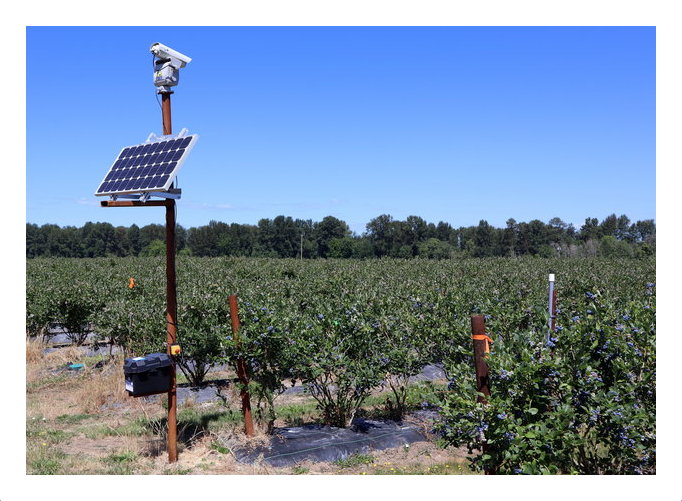
LASERS CAN STOP STARLINGS!
(July 20, 2018)
Owners of blueberry farms and cherry orchards outside Jefferson, Oregon have found a novel way to prevent flocks of starlings from destroying their crops without hurting the birds. They use lasers!
Read details of their 21st Century way of dealing with these avian thieves here: Lasers.
NEW DISCOVERIES MADE IN RESEARCH BASED ON BIRD BEHAVIOR
(February and March 2018)
Two important news stories dealt with scientific research into bird behavior. One was concerned with the effects of pecking into wood on the brains of woodpeckers as relating to research into human concussions. 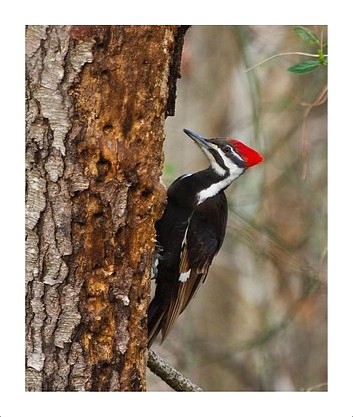 The second story explained how observers determined that Florida flamingos were not extinct as widely believed, but that the flamingos they kept seeing in Florida were, indeed, living and breeding in remote areas of the state.
The second story explained how observers determined that Florida flamingos were not extinct as widely believed, but that the flamingos they kept seeing in Florida were, indeed, living and breeding in remote areas of the state.
The article about woodpeckers was titled "Surprising findings in what really happens to a woodpecker's brains that mimics the impact of human concussions," written by John Hayes in the Pittsburgh Post-Gazette. This article was based on a research paper: "Why Do Woodpeckers Resist Head Impact Injury: A Biomechanical Investigation." authored by six researchers.
 The discovery of Florida's flamingos was an NPR news story on March 6, 2018: "Florida's Long-Lost Wild Flamingos Were Hiding In Plain Sight." It too is based on a research paper in the American Ornithological Society's publication The Condor: "Status and trends of American Flamingos (Phoenicopterus ruber) in Florida, USA," authored by seven researchers.
The discovery of Florida's flamingos was an NPR news story on March 6, 2018: "Florida's Long-Lost Wild Flamingos Were Hiding In Plain Sight." It too is based on a research paper in the American Ornithological Society's publication The Condor: "Status and trends of American Flamingos (Phoenicopterus ruber) in Florida, USA," authored by seven researchers.
Click on each title above to read the complete story or research paper.
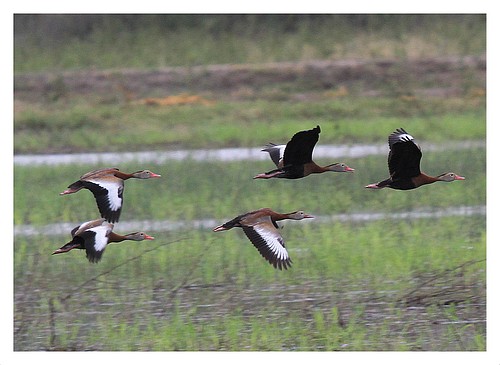
SANTA ANA NWR REPRIEVE?
(February 2018)
(The Peregrine editor Paul Hess received this message from "The Birding Community E-Bulletin" on a topic of interest to 3RBC members who visit the Rio Grande Valley. This monthly newsletter has much of interest to birders. Check it out and register free at tinyurl.com/E-bulletinSIGNUP.)
Birders, refuge friends, and conservationists of all stripes have been watching developments at Santa Ana National Wildlife Refuge for almost a year, concerned that plans for construction of a huge border wall would be accelerated, possibly isolating or destroying valuable habitat in the Refuge System in the Lower Rio Grande Valley of Texas. We summarized much of the dire concern in the February issue: tinyurl.com/Feb18Ebulletin.
Last month, when the 2,232-page omnibus spending bill was passed by Congress and signed by President Trump, it contained a particular short sentence in reference to The Wall: "None of the funds provided in this or any other Act shall be obligated for construction of a border barrier in the Santa Ana National Wildlife Refuge."
Thus, the long, contentious, and unexpected struggle over The Wall at bird-rich Santa Ana seems to have come to a close. The spending bill includes $1.6 billion for border barriers and technology, with restrictions on the kind of construction that can be done to only existing fencing, but Santa Ana NWR is essentially exempt. "The bill is very explicit in keeping any new border walls from going up in Santa Ana," said Scott Nicol, co-chairman of the Sierra Club Borderlands. "I think we were successful in making walling off Santa Ana politically toxic."
Originally, the Santa Ana border wall was looking like a pilot project for other sections of the wall, if only because the land was federally owned and a place where a wall might be easily built. In addition, the Administration had issued bidding guidelines that drew on elements of eight prototypes that were each about 30 feet (9.1 meters) high, much higher than existing barriers.
But the reprieve may be temporary. "This bill stated that there wasn't going to be any funding allotted for this year, but that doesn't mean that, that may not happen next year," said RGV No Border Wall organizer Melinda Melo.
Moreover, the threat still looms for other Lower Rio Grande Valley locations like the National Butterfly Center, Bentsen-Rio Grande State Park, La Lomita chapel, and home-and-farm properties owned by individuals along the Rio Grande.
The border wall battles over habitat in the Lower Rio Grande Valley will surely continue.
(Photo: Black-bellied Whistling Ducks flying at Santa Ana NWR)
Thanks to Jack Solomon for compiling a list of all the 3RBC Speakers from 2001 to December 2017.

THINGS LOOKED BLEAK UNTIL SNAIL KITES RAPIDLY EVOLVED BIGGER BEAKS
OVER A SHORT SPAN OF 13 YEARS!
(November 28, 2017)
Invasive species of snails much larger than native species caused young Snail Kites to evolve larger beaks to eat them and survive their first year of life. Read the details of this heartening news as the numbers of Snail Kites rebound in the Florida Everglades.
The New York Times article can be found at this link: Snail Kites.

BIRD CONSERVATION GROUPS HAVE WON A FIGHT AGAINST A GREAT LAKES WIND PROJECT
(June 29, 2017)
Here is some good environmental news for a change! The American Bird Conservancy and Black Swamp Bird Observatory of the Magee Marsh area have successfully halted a planned wind turbine project in a major bird migration corridor close to the shores of Lake Erie. See the complete story here Great Lakes Success Story.
Read a Birding Interview with the Bobs: Robert C. Leberman and Robert S. Mulvihill. First publish in the July/August 2013 issue of the magazine.
Photo Stories

TWO NOTABLE BIRD DISCOVERIES BY 3RBC MEMBERS
by Paul Hess (August 2018)
Here's something for birders to envy:
In August 2018, Frank and Adrienne Izaguirre were birding their way through the New Hampshire mountains as part of their quest to see 100 birds in every state.
Their first great find came when Adrienne noticed a small cormorant beside a larger one. Frank got a few quick photos before the bird flew.
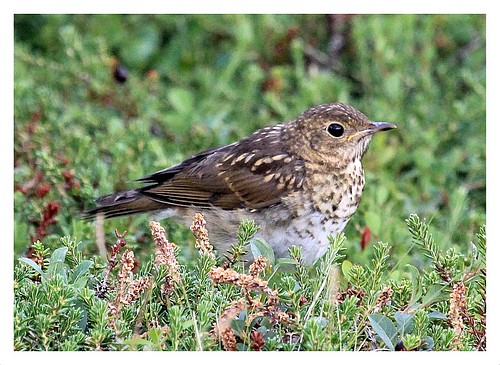 Confirming their suspicion, the bird turned out to be a Neotropic Cormorant - a first record for New Hampshire and all of New England!
Confirming their suspicion, the bird turned out to be a Neotropic Cormorant - a first record for New Hampshire and all of New England!
The next surprise - this one a life bird for them - was a fledgling Bicknell's Thrush. Many birders have not managed to see a rare Bicknell's, and even fewer have ever seen a cute fledgling. Adrienne spotted that one first, too.
Photos by Frank Izaguirre

photo by Geoff Malosh
February 3, 2018
TWO WESTERN BIRDS MADE THEIR FIRST EVER VISIT TO PENNSYLVANIA
(May 2018)
Two remarkable, beautiful, and super-rare visitors to western Pennsylvania in winter and spring 2018 thrilled birders who were lucky enough to see them: a Gray-crowned Rosy-Finch in February and a Varied Bunting in May. Both species were the first ever recorded in our state.
Shawn Collins learned of the rosy-finch at a friend's feeder in Meadville, Crawford County, on February 2, and arranged with the homeowners for birders to visit the house on a controlled schedule and watch the bird closely through a window. Photographers had a field day during its extended stay early in the month.
The bunting was present at a residential feeder only May 5-7 in Elizabeth, Allegheny County, and Dave Wilton coordinated arrangements for birders to visit the house. Its short stay allowed fewer birders to see it than the rosy-finch.
What brought these to Pennsylvania must remain a mystery. The rosy-finch breeds in the northwestern U.S. and Canada, and winters southward to New Mexico in the Rocky Mountain region. Why should it suddenly turn up here in mid-winter? Perhaps it was misoriented in its southbound migration in the fall and wandered around aimlessly during the early winter. Perhaps it was suddenly pushed eastward by a strong weather system. Or perhaps some other behavior was involved.
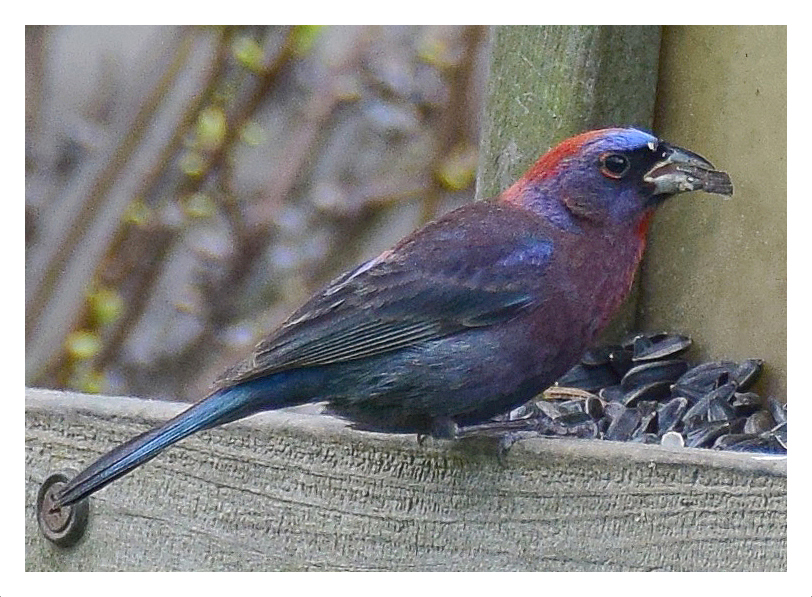
photo by Todd Hooe
May 7, 2018
For handy information about both of these species, follow the links to the Cornell Lab of Ornithology's website "All About Birds."
Gray-crowned Rosy-Finch
Varied Bunting
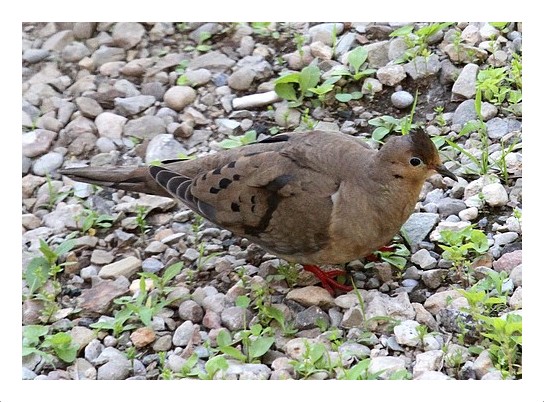
Addendum to Tom Moeller's Melanistic Birds Observations Article
(May 2018)
In the May-June 2017 edition of The Peregrine, Tom Moeller wrote about 'Birds from the Dark Side,' melanistic birds. On May 29, 2018, a melanistic Mourning Dove visited his yard with unusual brown/black pigment concentrations in its plumage. Overall the bird was dark, but two spots, one in the wing and one on its head, stood out. The one on the head made the bird appear to be wearing a toupee!!
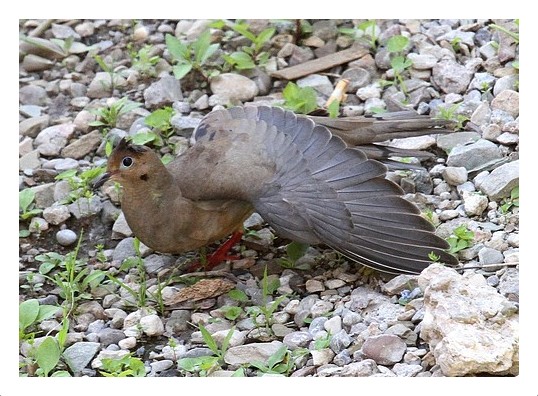
Here the dove stretched its wing to reveal darker than normal primaries and
redder than normal legs.
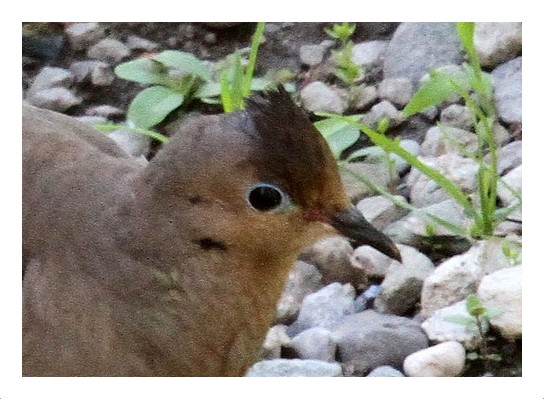 Detail of the head shows what appears to be a toupee of dark feathers on top of the dove's head.
Detail of the head shows what appears to be a toupee of dark feathers on top of the dove's head.
In honor of the black newsboy cap Jack Solomon often wears, we'll call this bird a "Jack's Mourning Dove."





